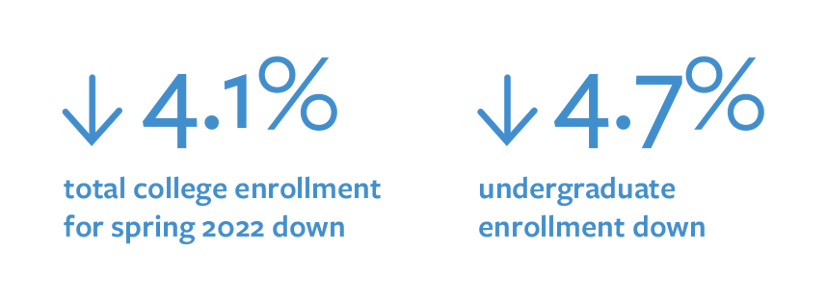
You’ve done your best when it comes to predicting how many students will enroll in the upcoming semester, but can you adjust to real-time enrollment fluctuations? Consistent collaboration between academic affairs and enrollment management is an essential component of smart scheduling.
Why Smart Scheduling Matters
Smart scheduling is a hot button topic for students and institutions alike. According to a recent report from National Student Clearinghouse, total college enrollment for spring 2022 fell by 4.1 percent, with undergraduate enrollment falling by 4.7 percent. And with an increased number of potential students questioning the value of a degree, now is the time to determine if your institution is making the most of its enrollment process.
 Enrollment and class scheduling are critical sources of information for current and prospective students. Knowing the class schedule in advance allows students the ability to organize their school schedule around home life, childcare and work. Many students want to be full-time but often can’t make a full-time schedule work. Too often, colleges rely primarily on "roll forward" scheduling instead of taking a student-centered approach. The result? Scheduling conflicts and lack of availability that shift a full-time student to part-time status, lengthening overall time to completion.
Enrollment and class scheduling are critical sources of information for current and prospective students. Knowing the class schedule in advance allows students the ability to organize their school schedule around home life, childcare and work. Many students want to be full-time but often can’t make a full-time schedule work. Too often, colleges rely primarily on "roll forward" scheduling instead of taking a student-centered approach. The result? Scheduling conflicts and lack of availability that shift a full-time student to part-time status, lengthening overall time to completion.
Send it to Your Inbox!
Download your copy of Why Smart Scheduling Matters. Fill out the form below and we will send it to your inbox!
 Holding Onto the Status Quo
Holding Onto the Status Quo
While there are many tools out there designed to assist in the enrollment management process, the use of enrollment data is far from standardized and may not always be welcomed or understood by decision makers. Potential students are increasingly asking if higher education is still worth it, requiring a greater sense of urgency around the monitoring of active registration.
The benefits of doing so are many. Monitoring enrollment can prepare an institution for a pipeline of new and prospective students, reduce late or changing schedules, and free up space, funding and/or teaching capacity constraints. It also ensures students get the classes they want and need without last-minute cancelations or schedule disruptions. Tools like Monitor & Predict from Ad Astra help institutions respond to enrollment trends in efficiently by providing real-time data around fluctuations.
Recognize scheduling and class schedules are a primary source of anxiety for students
![]()
Boost communication and collaboration between academic affairs and enrollment management
![]()
Use data to inform decisions on late or changing schedules
and to free up space, funding and/or teaching capacity constraints
![]()
Train decision makers on understanding and using enrollment data optimally
Survey current students regularly on scheduling wants and needs
Collaborate and Communicate
Building a better scheduling strategy begins with a team approach. This Completion Coalition should include members of the Registrar’s office and advisors who work directly with students along with decision makers: deans and department chairs and those in Provost’s office. These team members must also have an ability to understand and access timely enrollment data. Many institutions leverage reporting and tracking solutions that work in tandem with their Student Information Systems (SISs.)
Without this it becomes easy to fall back on the status quo, a decision that could impact retention of current students and deplete the pool of prospective students. Institutions that do not make this a priority could suffer a downturn in institutional revenue as students shift from full-time to part-time status or leave the institution in frustration.
Collaboration between enrollment management and academic affairs, paired with the application of timely data, can help institutions maximize the use of resources while ensuring students achieve degree velocity, a key measurement for students and institutions alike.
Authors
Jim Black
President and CEO of SEM (Strategic Enrollment Management) Works
Laura Kelley
VP of Solution Strategy, Ad Astra

Ad Astra is higher education’s solution partner in managing the academic enterprise. Partnering with more than 500 colleges, universities, and systems nationwide, Ad Astra helps improve stewardship of instructional resources, streamline student access to courses, and accelerate student completions.